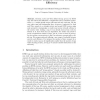CTRSA
2008
Springer
14 years 4 months ago
2008
Springer
CTRSA
2008
Springer
14 years 4 months ago
2008
Springer
Recently, Juels and Weis defined strong privacy for RFID tags. We add to this definition a completeness and a soundness requirement, i.e., a reader should accept valid tags and onl...
CTRSA
2008
Springer
14 years 4 months ago
2008
Springer
We propose two constructions of chosen-ciphertext secure identity-based encryption (IBE) schemes. Our schemes have a security proof in the standard model, yet they offer performan...
CTRSA
2008
Springer
14 years 4 months ago
2008
Springer
We motivate and describe the problem of finding protocols for multiparty computations that only use a single broadcast round per computation (latency-free computations). We show t...
CTRSA
2008
Springer
14 years 4 months ago
2008
Springer
Oblivious transfer, first introduced by Rabin, is one of the basic building blocks of cryptographic protocols. In an oblivious transfer (or more exactly, in its 1-out-of-2 variant...
CTRSA
2008
Springer
14 years 4 months ago
2008
Springer
Public key based authentication and key exchange protocols are not usually designed with privacy in mind and thus involve cleartext exchanges of identities and certificates before ...
CTRSA
2008
Springer
14 years 4 months ago
2008
Springer
Abstract. Camellia and MISTY1 are Feistel block ciphers. In this paper, we observe that, when conducting impossible differential cryptanalysis on Camellia and MISTY1, their round s...
CTRSA
2008
Springer
14 years 4 months ago
2008
Springer
In 2001, Bellare, Namprempre, Pointcheval and Semanko introduced
CTRSA
2008
Springer
14 years 4 months ago
2008
Springer
We propose and investigate the notion of aggregate message authentication codes (MACs) which have the property that multiple MAC tags, computed by (possibly) different senders on ...
CTRSA
2008
Springer
14 years 4 months ago
2008
Springer
We develop new algorithmic and cryptographic techniques for authenticating the results of queries over databases that are outsourced to an untrusted responder. We depart from previ...

